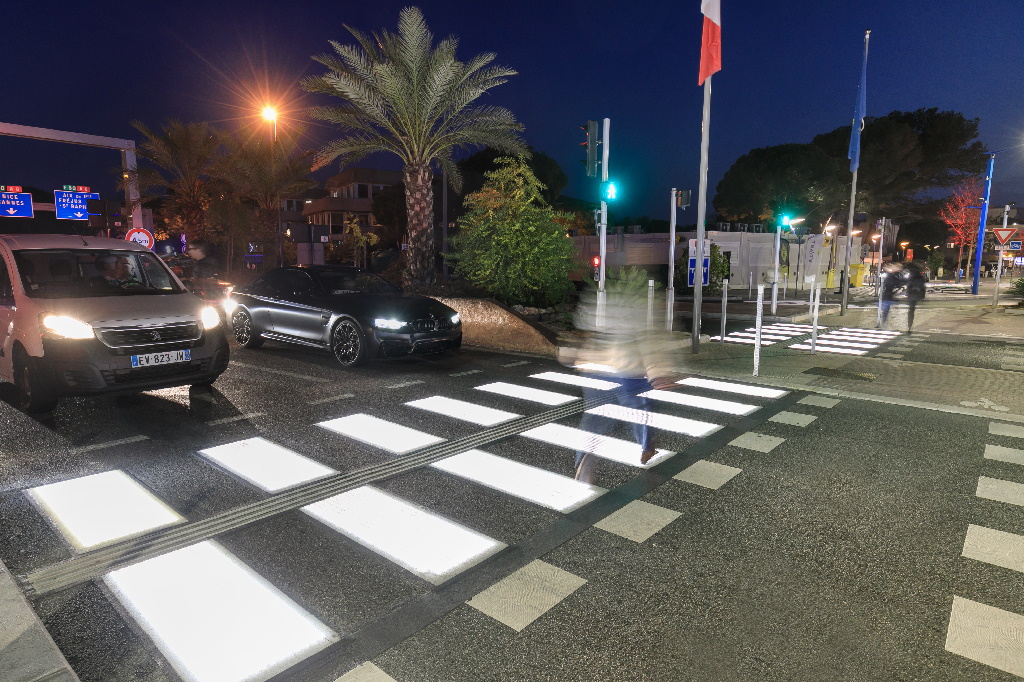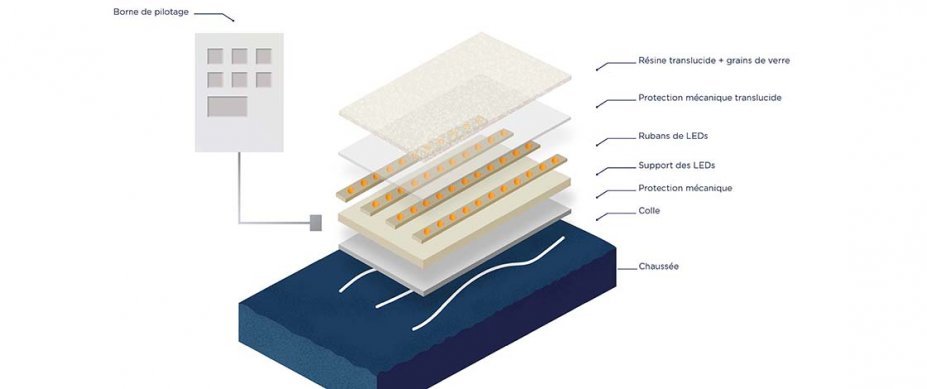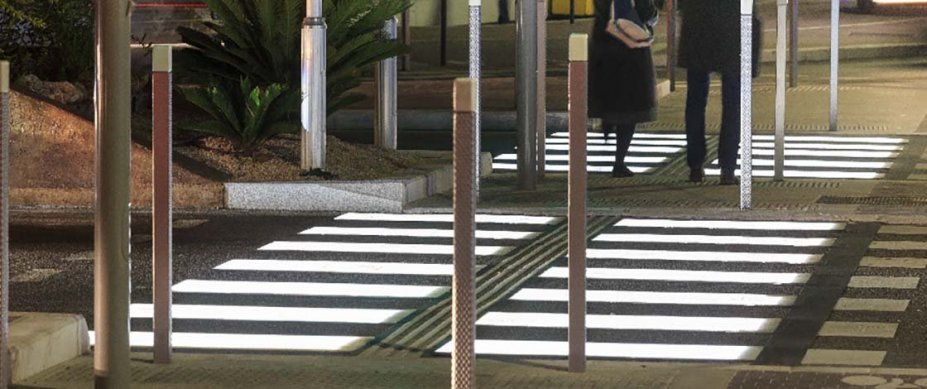Beyond building infrastructure, the Colas Group develops innovations that adapt to existing infrastructures. Flowell, a scalable and modular solution, is an example. It aims to optimise urban space and can, at its scale, improve the lives of road users by contributing to the safe movement of vehicles and people.
Today, infrastructure is shared and becomes more than a vector of mobility. The road, from a place of passage, must become a place of sharing with new services for users. The Colas Group's ambition is to support changes in behaviour and to engage in the construction of the "smart road", an unprecedented offer of connected, scalable and modular roads.
Invested in R&D through the Magny-les-Hameaux Scientific and Technical Campus (the world's leading private research centre in the field of roads), the Colas Group develops innovative products and processes that adapt to existing infrastructures and develops technical solutions that meet the necessary evolution of their uses.
The Flowell innovation, which allows a complementary use of transport infrastructure, is an operational translation of this. Its unique technology meets the growing need to share and secure public spaces. In on mode, Flowell reinforces horizontal signage for better visibility. In off mode, the floor markings disappear completely, modulating the urban space. This marking revolution aims to improve traffic flow, user safety and the coexistence of multiple forms of transport.
SHARING AND SECURING PUBLIC SPACE
Flowell contributed to the transformation of the city. It makes it more flexible to meet the expectations of its inhabitants and their new behaviours in terms of mobility.
For example, the transition from a continuous line to a broken line, with appropriate signalling, may free up a lane normally reserved for priority vehicles for the benefit of general traffic or temporarily assign the roads to a category of users.
At its scale, it can therefore improve the lives of road users, contributing to the fluidification of traffic and the safe movement of vehicles and people, especially in dense areas such as urban and interurban areas. This dynamic lighting solution increases the visibility of signage, especially in the rain or at night, and thus secures areas dedicated to the most exposed users such as pedestrians and cyclists. This increased visibility makes it easier for the most vulnerable people – such as children and the elderly – to cross and thus improve their safety.
A RESPONSE TO ROAD SAFETY REQUIREMENTS
The Flowell light-signalling principle makes it possible to create several forms of slabs as needed : 10 or 15 cm wide strips, pedestrian crossings, but also directional arrows. The specific LEDs used in the slabs ensure efficient floor markings. Coupled with a brightness sensor, they intelligently adapt to the intensity of ambient light during the day and night, thus avoiding obstructing the visibility of motorists and residents.
To ensure the safety dimension of the floor markings, Flowell's electrical circuits are doubled and independent of each other. The management of ignition modes is dealt with specifically for each experiment, depending on the site, the nature of the signals to be sent and the objectives to be achieved.
In off mode, Flowell currently meets regulatory requirements1-3. In addition, with this solution in on-mode mode, the road marking emits its own light, making the usual certification principles based on retro-reflection obsolete.
SCIENTIFIC AND TECHNICAL SUPPORT FROM CEREMA
Cerema (Centre for Studies and Expertise on Risks, the Environment, Mobility and Planning) is a Carnot-labelled public institution that supports the development of innovative products concerning public spaces, their uses and associated services, including road signs and public transport.
Cerema's mission is to deploy its expertise, particularly on specific themes: the framing of experiments, the definition of behavioral studies and the search for new measurement equipment to qualify innovation.
Last March, Colas and Cerema signed an agreement to set up a scientific and technical support program to support Flowell development and experimentation. First of all, Cerema aims to assist Colas in the management of in situ experiments and the definition of behavioural studies. The particularity of Flowell being to make the road marking dynamic and programmable, it is necessary to understand and evaluate the induced impacts on users according to the modes of operation of the innovation. In off mode, the slabs can be invisible and make a message disappear from the pavement to better share the space. Cerema will be able to analyze the impact of the phantom effect (optical effect generated by a surface placed on the road) on the various experimental sites in order to limit the risks to users.
As soon as the slabs are lit, Flowell ensures better visibility of horizontal signage. Cerema's mission is to define future equipment that will measure the quality and quantity of light emitted by Flowell in lit mode, whether during the day, at night, in rainy or wet weather. These measures will help to establish the performance required to integrate light signalling into the interministerial road safety instruction.
![]()
A TECHNOLOGY RESULTING FROM COLAS INNOVATION
Flowell was born from a reflection led by Colas teams. This solution incorporates tiles, composed of LEDs encapsulated in a multilayer substrate and connected to an electrical network. These slabs are themselves connected to control terminals.
Glued or embedded in the roadway, this coating of a few millimeters thick can have a variable roughness depending on its use. Flowell has been designed to adapt to many situations, in particular by adjusting the dimensions and shapes of the slabs as needed.
After a first phase of laboratory research conducted in collaboration with CEA Tech (technological research department of the French Alternative Energies and Atomic Energy Commission), Flowell is now entering its experimental phase in real conditions of use. The first demonstrators are produced by the CEA Tech FabLab.
![]()
EXPERIMENTATION IN REAL CONDITIONS IN MANDELIEU-LA-NAPOULE
Flowell's first experiment began in Mandelieu-la-Napoule (Alpes-Maritimes)on March 1, 2019. It aims to test in real conditions, on one of the main intersections of the city which is also an exit of the A8 motorway, Flowell's interest in reducing dangerous behaviour on particularly sensitive pedestrian crossings.
Specifically, 23 Flowell strips are superimposed on the traditional marking of the pedestrian crossing. The status control of the strips (on/off) is controlled by the state of the traffic lights on three pedestrian crossings, and the last by automatic presence detection. This first experiment aims to identify the most efficient mode of operation possible for all users. Different scenarios will be studied successively over 24 months by evaluating the trigger modes (programmed, push button, detector) and lighting modes (fixed light, flashing, scrolling). These different scenarios will be implemented through field observation, in accordance with the request for experimentation made to the Ministries of Transport and the Interior, Road Safety Delegation.
The Flowell experiment in Mandelieu-la-Napoule has many objectives in terms of safety for users:
- fluidify pedestrian crossings while respecting crossing times;
- secure pedestrian crossings by encouraging pedestrians to respect traffic lights and pedestrian paths;
- encourage motorists to decelerate earlier thanks to better visibility of the crosswalk;
- highlight the presence of a pedestrian.
Each objective has its own measurement indicators and studies are carried out on the equipment to understand:
- To what extent the dynamic character and increased visibility of the pedestrian crossing thanks to Flowell induces a better adaptation of the speed of the vehicle to the approach.
- If pedestrians take ownership of the operation of this new dynamic marking system.
- These studies focus in particular on visibility performance under different light conditions (in direct sunlight, day, night, and in all seasons).
USE CASES TO EXPERIMENT
In the short term, Flowell's main use case is the luminous reinforcement of existing floor markings to improve its visibility and the safety of its immediate environment. The illuminated pedestrian crossing is an example, as is securing bus stops or illuminating a speed bump to better alert approaching vehicles.
In a second step, the evolutionary ground marking will contribute to the implementation of prioritization of public transport lanes or the creation of illuminated folding arrows for better visibility in difficult weather. In the longer term, the dynamic allocation of lanes will make it possible to improve traffic flow and thus improve the coexistence of multiple forms of transport. With Flowell, the road, a place of passage, thus becomes a place of sharing in which everyone finds their place safely.






